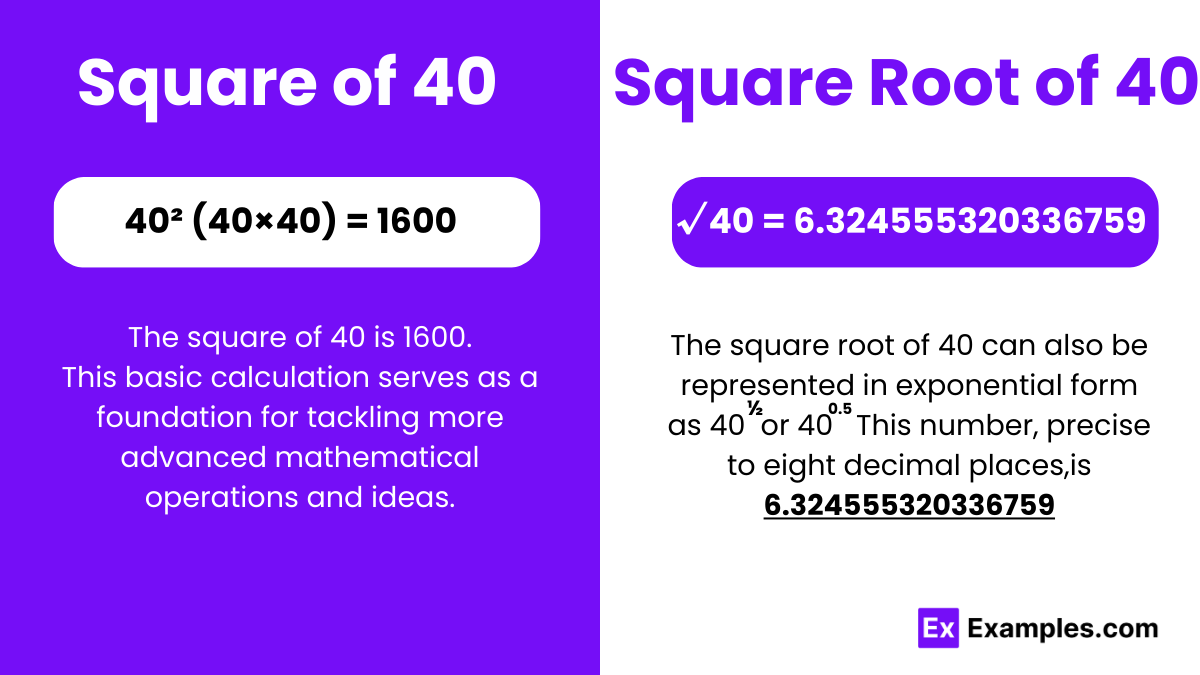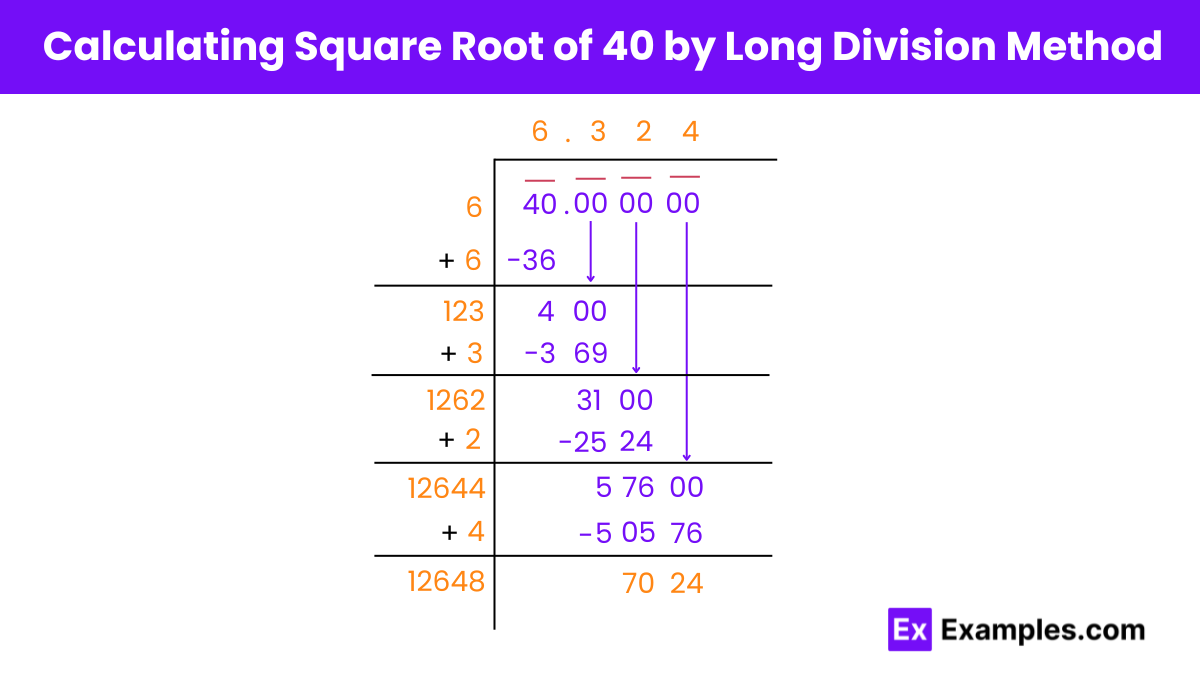What is the square of 40?
1600
1560
1640
1580

The “square of 40” represents the outcome when the number 40 is multiplied by itself.
In mathematical notation, it’s denoted as 40². To compute the square of 40, you multiply 40 by 40, resulting in 1600.
Calculating the square of 40 entails straightforward arithmetic, involving the multiplication of 40 by itself. This calculation is frequently encountered in various mathematical contexts, notably in geometry and algebra.
√40 = 6.324555320336759
or
√40 = 6.324 up to three decimal places
The square root of 40, denoted as √40, is a fundamental mathematical concept representing the value that, when multiplied by itself, equals 40. Unlike whole numbers or fractions, the square root of 40 is an irrational number, meaning its decimal expansion is non-repeating and infinite. When approximated, the value of √40 is approximately 6.324555320336759. Despite its seemingly unpredictable decimal expansion, the square root of 40 is essential in various mathematical calculations, geometric analyses, and practical applications. Understanding this concept aids in problem-solving across disciplines like engineering, physics, and finance.
Square Root of 40: 6.324555320336759
Exponential Form: 40^½ or 40^0.5
Radical Form: √40
To understand why, let’s first define rational and irrational numbers.
Rational numbers are those expressible as a fraction of two integers, where the denominator is not zero, written as a/b.
Examples include 1/2, -3, and 5.
Irrational numbers, however, cannot be expressed as simple fractions of two integers. Their decimal representations are non-repeating and non-terminating.
Examples include √2, π (pi), and √3.
Square Root of 40 as Irrational:
When we calculate the square root of 40, we find it cannot be expressed as a fraction of two integers.
Its decimal expansion, approximately 6.324555320336759, continues infinitely without repeating a pattern.
Let’s simplify:
√40 = √(4 × 10) = √4 × √10 = 2 × √10
Since √10 is famously irrational, the product of a rational number (2) and an irrational number (√10) is also irrational.
In summary, the square root of 40 is irrational because it simplifies to an irrational number (√10) when multiplied by a rational number (2), resulting in an irrational product.
When determining the square root of 40, various methods are available, each with its own merits depending on your mathematical background and the desired precision level.
These methods furnish clear strategies for calculating the value of the square root of 40, accommodating various skill levels and preferences in mathematical reasoning.

Finding the square root of 40 using the long division method involves the following steps:
Step 1: Preparation
Write 40 as 40.00 00 00, grouping digits in pairs from the decimal point. For 40, it looks like “40”.
Step 2: Find the Largest Square
Identify the largest square smaller than or equal to 40, which is 36 (6²). Place 6 above the line as the first digit of the root.
Step 3: Subtract and Bring Down
Subtract 36 from 40 to get 4, then bring down the next pair of zeros to make it 400.
Step 4: Double and Find the Next Digit
Double the current result (6) to get 12. Now, find a digit (X) such that 612 multiplied by X is less than or equal to 400. Here, X is 6, because 6126×6=372.
Step 5: Repeat with Precision
Subtract 372 from 400 to get 28, bring down the next zeros to get 2800, then double the quotient (66) to get 132. Choose a digit (Y) so that 132Y multiplied by Y is just under 2800.
Step 6: Finish at Desired Accuracy
Continue the process until reaching the desired level of accuracy. For the square root of 40, this method gives us about 6.324 as we extend the division.
A perfect square root is a number that can be expressed as the product of an integer multiplied by itself. For example, 4 (2 × 2) and 9 (3 × 3) are perfect square roots. To determine whether 40 is a perfect square root, we check if it can be written as the product of two identical integers.
However, upon examination, we find that there are no two integers x such that x × x equals 40. In other words, 40 cannot be expressed as the square of any integer.
Therefore, 40 is not a perfect square root. It does not have an integer square root. While it does have a square root (√40), it’s an irrational number and cannot be obtained by multiplying any whole number by itself.
In summary, 40 is not a perfect square root as it cannot be expressed as the product of two identical integers.
Is the Square Root of 40 a Real Number?
Yes, the square root of 40 is a real number. A real number is any value that can be found on the number line, including both rational and irrational numbers. Since the square root of 40 falls within this range, it is considered a real number.
What is the side length of square root 40?
The side length of a square with an area equal to 40 can be found by taking the square root of 40. Therefore, the side length of a square with an area of 40 units is √40 units.
What square root is between 40?
he square root of 40 is approximately 6.324. Therefore, the square root between 40 is a number that lies between 6 and 7. One such square root between 40 is √36, which equals 6. This indicates that the square root of 36 is the largest perfect square less than 40.
Text prompt
Add Tone
10 Examples of Public speaking
20 Examples of Gas lighting
What is the square of 40?
1600
1560
1640
1580
Which number is closest to the square root of 40?
6.2
6.3
6.4
6.5
If y² = 40, what is y approximately?
6.3
6.4
6.5
6.6
Simplify √40 to its decimal form.
6.32
6.33
6.34
6.35
What is (40)²?
1560
1600
1620
1640
Find the approximate value of √40 to one decimal place.
6.3
6.4
6.5
6.6
Which of the following numbers is a perfect square and closest to 40?
36
49
64
25
What is the value of 40 raised to the power of 0.5?
6.31
6.32
6.33
6.34
Calculate 40 × 40.
1580
1600
1620
1640
What is √40 between which two integers?
6 and 7
5 and 6
7 and 8
8 and 9
Before you leave, take our quick quiz to enhance your learning!

